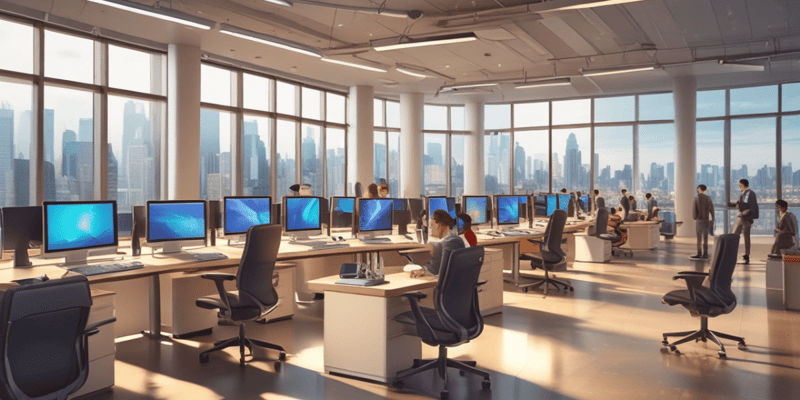Podcast
Questions and Answers
How does low-level illuminance affect performance appraisals and memory rate?
How does low-level illuminance affect performance appraisals and memory rate?
Low-level illuminance contributes to higher performance appraisals and a better long-term memory rate.
What impact do warmer temperatures have on cognitive performance?
What impact do warmer temperatures have on cognitive performance?
Warmer temperatures can lead to better cognitive performance.
According to a Purdue University study, what benefits were observed in workers who could easily adjust room temperature?
According to a Purdue University study, what benefits were observed in workers who could easily adjust room temperature?
They were more engaged, used less building energy, reported higher levels of productivity, and performed better in cognitive tests.
How does high-level illuminance affect people's alertness and energy levels?
How does high-level illuminance affect people's alertness and energy levels?
Signup and view all the answers
Why is it important to provide a range of temperatures in the workplace?
Why is it important to provide a range of temperatures in the workplace?
Signup and view all the answers
How can lighting control influence mental workload in the workplace?
How can lighting control influence mental workload in the workplace?
Signup and view all the answers
How does warm-white color temperature affect cognitive performance?
How does warm-white color temperature affect cognitive performance?
Signup and view all the answers
What is the optimal color temperature and illumination for mental workload reduction according to NASA's study?
What is the optimal color temperature and illumination for mental workload reduction according to NASA's study?
Signup and view all the answers
How does the color temperature of a lamp affect sustained attention?
How does the color temperature of a lamp affect sustained attention?
Signup and view all the answers
According to the Purdue University study, what benefits were observed in workers who could easily adjust room lighting?
According to the Purdue University study, what benefits were observed in workers who could easily adjust room lighting?
Signup and view all the answers
How do individual preferences for lighting affect workplace comfort?
How do individual preferences for lighting affect workplace comfort?
Signup and view all the answers
What are the benefits of providing individual control over temperature and lighting in the workplace?
What are the benefits of providing individual control over temperature and lighting in the workplace?
Signup and view all the answers
Study Notes
Temperature and Lighting Control: Optimizing Workplace Performance
As technology advances and indoor environments continue to evolve, the importance of optimizing temperature and lighting control in the workplace has become increasingly recognized. This is particularly important in the context of cognitive performance and mental workload, which can be significantly influenced by lighting conditions. In this article, we will explore the effects of temperature and lighting control on cognitive performance, mental workload, and workplace productivity.
Temperature
Temperature plays a crucial role in determining cognitive performance, mental workload, and overall worker comfort. Studies have shown that low-level illuminance often contributes to higher performance appraisals and a better long-term memory rate, while high-level illuminance tends to make people less sleepy and more energetic. Additionally, research has demonstrated that warmer temperatures can lead to better cognitive performance.
The Purdue University study found that workers who could easily adjust room temperature were more engaged, used less building energy by relying more on daylight, and reported higher levels of productivity and performed better in cognitive tests compared to those using wall-mounted controls. However, individual preferences for temperature can vary greatly, and it is essential to provide a range of temperatures to accommodate different comfort levels and preferences.
Lighting
Lighting is another critical factor in workplace productivity and cognitive performance. Illuminance and color temperature are two indicators that can be controlled by artificial lighting, and they also affect human physiology and psychology. Studies have shown that lighting with warm-white color temperature usually results in better cognitive performance. Additionally, research has demonstrated that the color temperature of a lamp can significantly affect sustained attention, and higher color temperatures are associated with faster reaction times in attention-related tasks.
The Purdue University study found that workers who could easily adjust room lighting were more engaged, used less building energy by relying more on daylight, and reported higher levels of productivity and performed better in cognitive tests compared to those using wall-mounted controls. Similar to temperature, individual preferences for lighting can vary greatly, and it is essential to provide a range of lighting options to accommodate different comfort levels and preferences.
Interaction between Temperature and Lighting
The effects of temperature and lighting on cognitive performance and mental workload can be further complicated by their interaction. A study by NASA investigated the effects of different lighting conditions on mental workload, finding that the optimal lighting condition for mental workload reduction was a color temperature of 3000 K and illumination of 750 lx. However, the interaction between color temperature and illuminance in affecting mental workload was not significant.
Conclusion
In conclusion, optimizing temperature and lighting control in the workplace is essential for maintaining employee comfort, promoting cognitive performance, and reducing mental workload. By providing individual control over temperature and lighting, workers can adjust their environments to suit their comfort levels and preferences, leading to increased engagement, productivity, and overall workplace satisfaction. As technology advances and data becomes more readily available, it is anticipated that smart building technologies will continue to evolve, further optimizing temperature and lighting control in the workplace.
Studying That Suits You
Use AI to generate personalized quizzes and flashcards to suit your learning preferences.
Description
Explore the importance of optimizing temperature and lighting control in the workplace for enhancing cognitive performance, mental workload, and overall productivity. Learn about the effects of temperature, lighting, and their interaction on employee comfort and satisfaction.




